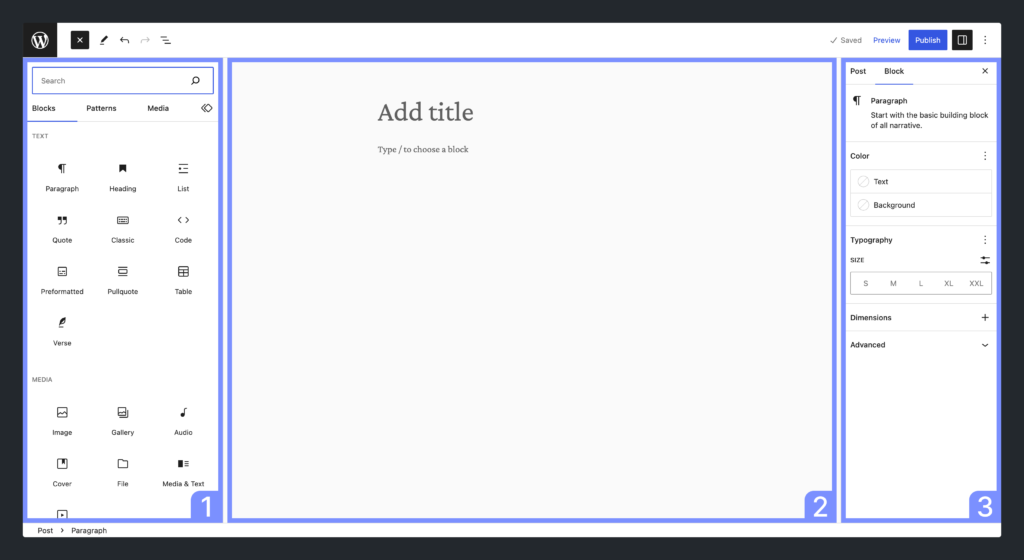Since its inception in 2003, WordPress has transformed from a simple blogging platform into one of the most widely used content management systems (CMS) globally. What started as a basic tool for bloggers has evolved into a robust solution that powers over 40% of all websites on the internet. In this post, we will learn more about the evolution of WordPress.
The journey of WordPress is marked by continuous innovation and adaptation to changing user needs and technology trends. This article explores the key changes that have shaped WordPress over the years.

1. The Origins of WordPress: A Simple Blogging Tool
WordPress was born from a collaboration between developers Matt Mullenweg and Mike Little. It was a fork of an existing project called b2/cafelog, which had been abandoned. The first version, WordPress 0.7, was released in May 2003, focusing on simplicity and user accessibility. The early versions provided basic functionality, including easy installation, clean permalinks, and the ability to manage links, categories, and posts.
At that time, WordPress was primarily a blogging platform. Its appeal lay in its open-source nature, which allowed anyone to modify and improve the software. The plugin architecture was introduced soon after in version 1.2, allowing users to extend WordPress’s functionality. This move set the foundation for WordPress to grow into a customizable and flexible CMS.
2. The Introduction of Themes and Customization (2005)
WordPress 1.5, released in 2005, introduced the concept of themes, revolutionizing the way websites were designed on the platform. Themes allowed users to change the appearance of their site with just a few clicks, without altering the core functionality. This was a significant step forward in democratizing web design, as users no longer needed extensive coding knowledge to create a visually appealing website.
With the introduction of themes, the WordPress community also began to grow. Developers could create and sell or distribute free themes, leading to a thriving ecosystem around design and functionality.
3. The Emergence of WordPress as a CMS (2008-2010)
By 2008, WordPress had begun to evolve beyond a simple blogging platform. Version 2.5 marked significant strides in usability, with a revamped admin dashboard and more intuitive user interface. This period also saw the introduction of the shortcode API, enabling users to easily insert complex features (like galleries or forms) into their content with simple codes.
The true shift towards becoming a full-fledged CMS came with the release of WordPress 3.0 in 2010. This version included features like custom post types, custom taxonomies, and a menu management system. Users could now create not just blog posts, but different types of content—like portfolios, products, and services. These developments positioned WordPress as a versatile platform for businesses, e-commerce sites, portfolios, and more.
4. The Rise of Plugins and the WordPress Ecosystem
One of WordPress’s key strengths has always been its extensibility through plugins. The introduction of plugins in version 1.2 laid the groundwork, but the true explosion of the plugin ecosystem occurred in the years following. By 2011, the WordPress plugin repository had thousands of plugins available, enabling users to add nearly any functionality imaginable to their website without touching code.
Popular plugins such as Yoast SEO (for optimizing websites for search engines), WooCommerce (for e-commerce functionality), and Jetpack (for enhanced security and performance) became essential tools for WordPress users. This ecosystem of plugins empowered users to create websites that were as simple or complex as needed, whether they were running blogs, e-commerce stores, membership sites, or news portals.
5. Mobile Responsiveness and the Rise of WordPress as a Mobile-Friendly Platform (2012)
With the rise of smartphones and tablets, the need for mobile-responsive websites became crucial. WordPress 3.4, released in 2012, brought mobile-friendly themes and features to the platform. The Twenty Twelve theme, introduced with this update, was the first default theme to be fully responsive, adapting automatically to different screen sizes.
This update made WordPress more relevant in a mobile-first world, ensuring that users could build websites that looked good and performed well across devices. The platform also introduced mobile apps, allowing users to manage their websites on the go.
6. The Introduction of the Customizer (2014)
One of the most significant changes to WordPress in recent years was the introduction of the WordPress Customizer in version 4.0. The Customizer allowed users to make changes to their site’s design in real-time. They could see a live preview of how their website would look before saving changes, making the design process much more intuitive.
This marked a major step forward in usability, as users no longer needed to jump between the back-end admin interface and the front-end of their site to see how their design changes affected the site’s appearance. The Customizer became a core part of WordPress and continues to be an essential feature for users looking to personalize their websites.

7. The Era of Gutenberg: A Block-Based Future (2018)
The release of WordPress 5.0 in December 2018 was arguably one of the most transformative updates in the platform’s history. This version introduced the Gutenberg editor, a block-based content editor that replaced the classic TinyMCE editor. Gutenberg fundamentally changed how users create and manage content on WordPress by shifting from a text-based approach to a visual, block-based one.
Each piece of content (text, images, videos, etc.) is treated as a “block,” which users can move around, resize, and customize easily. While the initial reception of Gutenberg was mixed, with many users finding the transition difficult, it has since evolved into a powerful tool for building dynamic, visually engaging pages without needing custom code.
The introduction of the block editor signified WordPress’s move towards a more modern, user-friendly interface, bringing it in line with other popular website builders like Wix and Squarespace. Since its launch, Gutenberg has continued to improve, with new blocks and functionalities added regularly.
8. WordPress and Full Site Editing (2020s)
Building on the foundations laid by Gutenberg, WordPress introduced Full Site Editing (FSE) in version 5.8, released in 2021. FSE allows users to design not just the content of their posts and pages but the entire layout of their site using blocks. Users can now edit headers, footers, and sidebars directly from the same interface they use to edit content.
FSE is a game-changer for users who want complete control over their site’s design but don’t have the technical expertise to code custom themes. It signifies a shift towards making WordPress an all-in-one solution for website building, empowering users to create highly customized designs without hiring a developer.
9. The Evolution of WordPress Security
As WordPress grew in popularity, it also became a target for security threats. Over the years, the platform has responded by enhancing its security features. Regular updates, stronger password enforcement, two-factor authentication, and compatibility with leading security plugins like Wordfence and Sucuri have made WordPress more secure.
The introduction of automatic updates for minor releases in WordPress 3.7 in 2013 was a significant step forward in keeping sites safe. Automatic updates ensure that WordPress websites receive important security patches as soon as they are available, reducing the risk of vulnerabilities.
10. The Future of WordPress: Continued Innovation
As we look towards the future, it’s clear that WordPress will continue to evolve. Key areas of focus include improving the performance of the platform, expanding on Full Site Editing, and enhancing the user experience through more intuitive design and functionality.
The WordPress community remains a driving force behind the platform’s evolution. With thousands of developers, designers, and users contributing to its growth, WordPress is likely to remain a dominant force in the world of web development for years to come.
Conclusion
The evolution of WordPress is a testament to its adaptability and commitment to serving the needs of its users. From its humble beginnings as a blogging tool to its current status as a comprehensive website-building platform, WordPress has continuously pushed the boundaries of what’s possible. As new technologies emerge and user expectations evolve, WordPress is sure to continue growing, providing users with the tools they need to create powerful, engaging websites.


